sensor RENAULT TWINGO 2009 2.G Electrical Equipment - Petrol Injection Owner's Manual
[x] Cancel search | Manufacturer: RENAULT, Model Year: 2009, Model line: TWINGO, Model: RENAULT TWINGO 2009 2.GPages: 348
Page 39 of 348
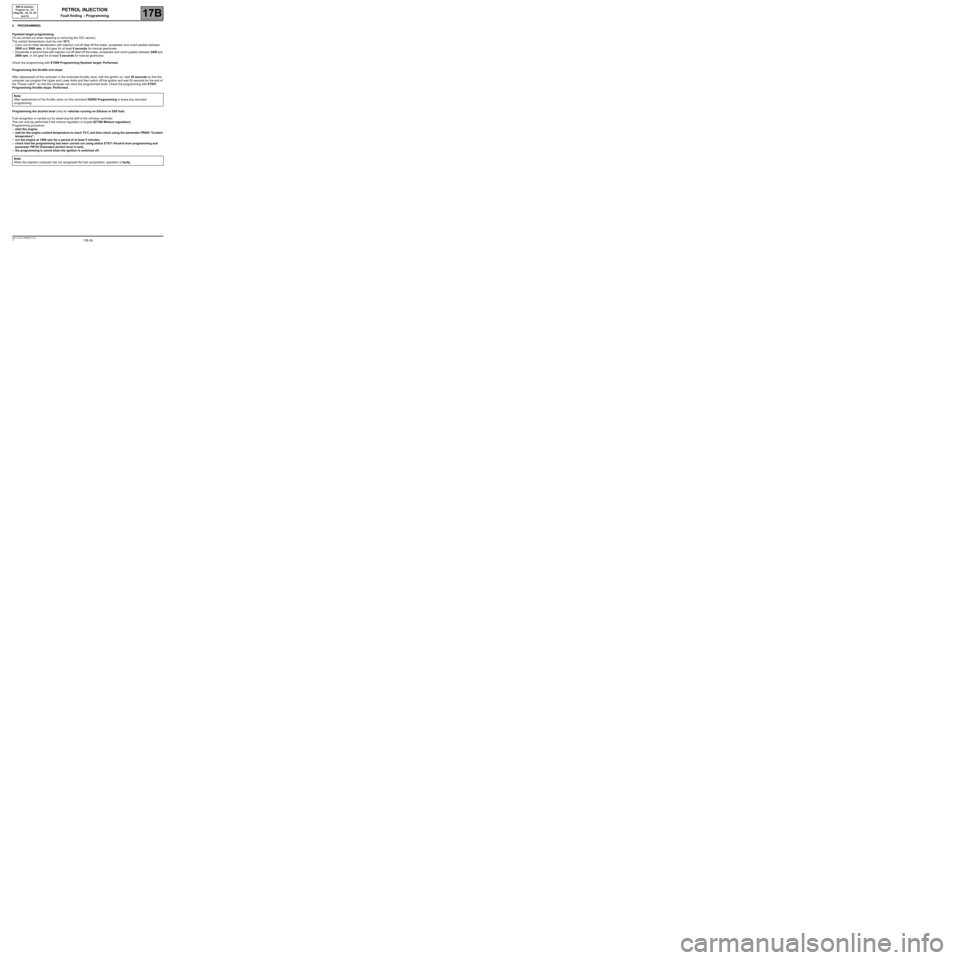
17B-39V7 MR-413-X44-17B000$110.mif
17B
SIM 32 Injection
Program no.: D3
Vdiag No.: 44, 4C, 50
and 54
2. PROGRAMMING
Flywheel target programming
(To be carried out when replacing or removing the TDC sensor).
The coolant temperature must be over 35˚C.
–Carry out an initial deceleration with injection cut-off (feet off the brake, accelerator and clutch pedals) between
3500 and 3000 rpm, in 3rd gear for at least 5 seconds for manual gearboxes.
–Decelerate a second time with injection cut-off (feet off the brake, accelerator and clutch pedals) between 2400 and
2000 rpm, in 3rd gear for at least 5 seconds for manual gearboxes.
Check the programming with ET089 Programming flywheel target: Performed.
Programming the throttle end stops
After replacement of the computer or the motorised throttle valve, with the ignition on, wait 30 seconds so that the
computer can program the Upper and Lower limits and then switch off the ignition and wait 30 seconds for the end of
the "Power Latch", so that the computer can store the programmed limits. Check the programming with ET051
Programming throttle stops: Performed.
Programming the alcohol level (only for vehicles running on Ethanol or E85 fuel)
Fuel recognition is carried out by observing the drift of the richness controller.
This can only be performed if the mixture regulation is looped (ET300 Mixture regulation).
Programming procedure:
–start the engine,
–wait for the engine coolant temperature to reach 75˚C and then check using the parameter PR064 "Coolant
temperature",
–run the engine at 1500 rpm for a period of at least 5 minutes,
–check that the programming has been carried out using status ET671 Alcohol level programming and
parameter PR743 Estimated alcohol level in tank,
–the programming is saved when the ignition is switched off. Note:
After replacement of the throttle valve run the command RZ005 Programming to erase any recorded
programming.
Note:
When the injection computer has not recognised the fuel composition, operation is faulty.
PETROL INJECTION
Fault finding – Programming
Page 40 of 348
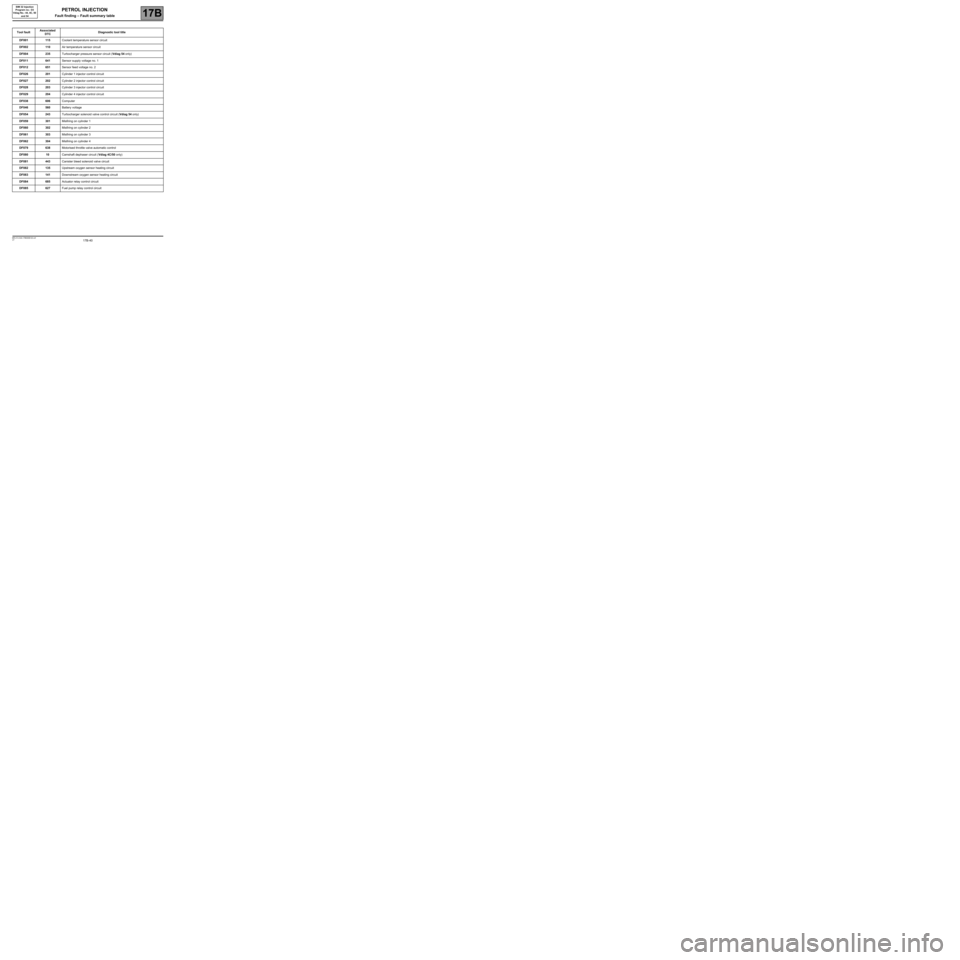
17B-40V7 MR-413-X44-17B000$120.mif
17B
SIM 32 Injection
Program no.: D3
Vdiag No.: 44, 4C, 50
and 54
Tool faultAssociated
DTCDiagnostic tool title
DF001115Coolant temperature sensor circuit
DF002110Air temperature sensor circuit
DF004235Turbocharger pressure sensor circuit (Vdiag 54 only)
DF011641Sensor supply voltage no. 1
DF012651Sensor feed voltage no. 2
DF026201Cylinder 1 injector control circuit
DF027202Cylinder 2 injector control circuit
DF028203Cylinder 3 injector control circuit
DF029204Cylinder 4 injector control circuit
DF038606Computer
DF046560Battery voltage
DF054243Turbocharger solenoid valve control circuit (Vdiag 54 only)
DF059301Misfiring on cylinder 1
DF060302Misfiring on cylinder 2
DF061303Misfiring on cylinder 3
DF062304Misfiring on cylinder 4
DF079638Motorised throttle valve automatic control
DF08010Camshaft dephaser circuit (Vdiag 4C/50 only)
DF081443Canister bleed solenoid valve circuit
DF082135Upstream oxygen sensor heating circuit
DF083141Downstream oxygen sensor heating circuit
DF084685Actuator relay control circuit
DF085627Fuel pump relay control circuit
PETROL INJECTION
Fault finding – Fault summary table
Page 41 of 348
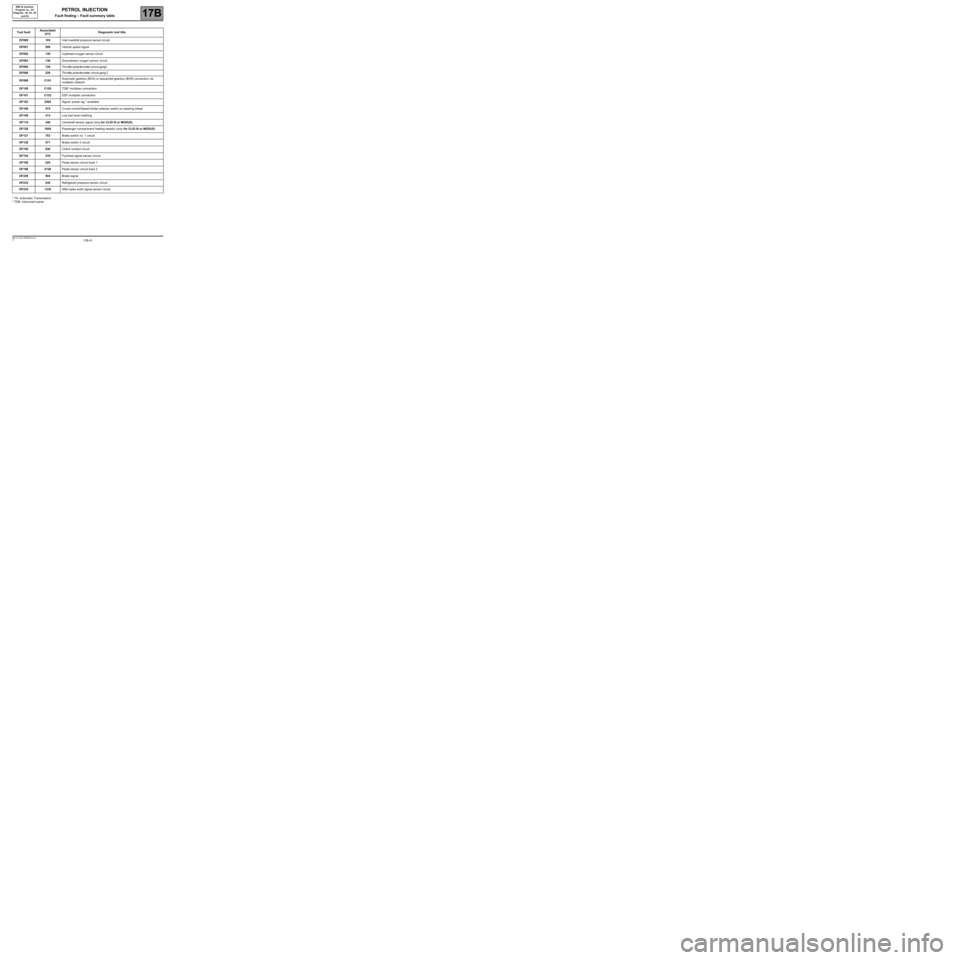
17B-41V7 MR-413-X44-17B000$120.mif
PETROL INJECTION
Fault finding – Fault summary table17B
SIM 32 Injection
Program no.: D3
Vdiag No.: 44, 4C, 50
and 54
* TA: Automatic Transmission
* TDB: Instrument panel
Tool faultAssociated
DTCDiagnostic tool title
DF089105Inletmanifold pressure sensor cir cuit
DF091500Vehicle speed signal
DF092130Upstream oxygen sensor circuit
DF093136Downstream oxygen sensor circuit
DF095120Th rottle potentiometer circuit gang1
DF096220Th rottle potentiometer circuit gang 2
DF099C101Automatic gearbox (BVA) or sequential gearbox (BVR) connection via
multiplex network
DF100C155TDB* multiplex connection
DF101C122ESP multiplex connection
DF1022502Signal: power sig.* available
DF106575Cruise control/Speed limiter selector switch on steering wheel
DF109313Low fuel level misfiring
DF119340Camshaft sensor signal (only for CLIO III or MODUS)
DF1261604Passenger compartment heating resistor (only for CLIO III or MODUS)
DF127703Brake switch no. 1 circuit
DF128571Brake switch 2 circuit
DF150830Clutch contact circuit
DF154335Flywheel signal sensor circuit
DF196225Pedal sensor circuit track 1
DF1982120Pedal sensor circuit track 2
DF228504Brake signal
DF232530Refrigerant pressure sensor circuit
DF2341335After-sales tooth signal sensor circuit
Page 42 of 348
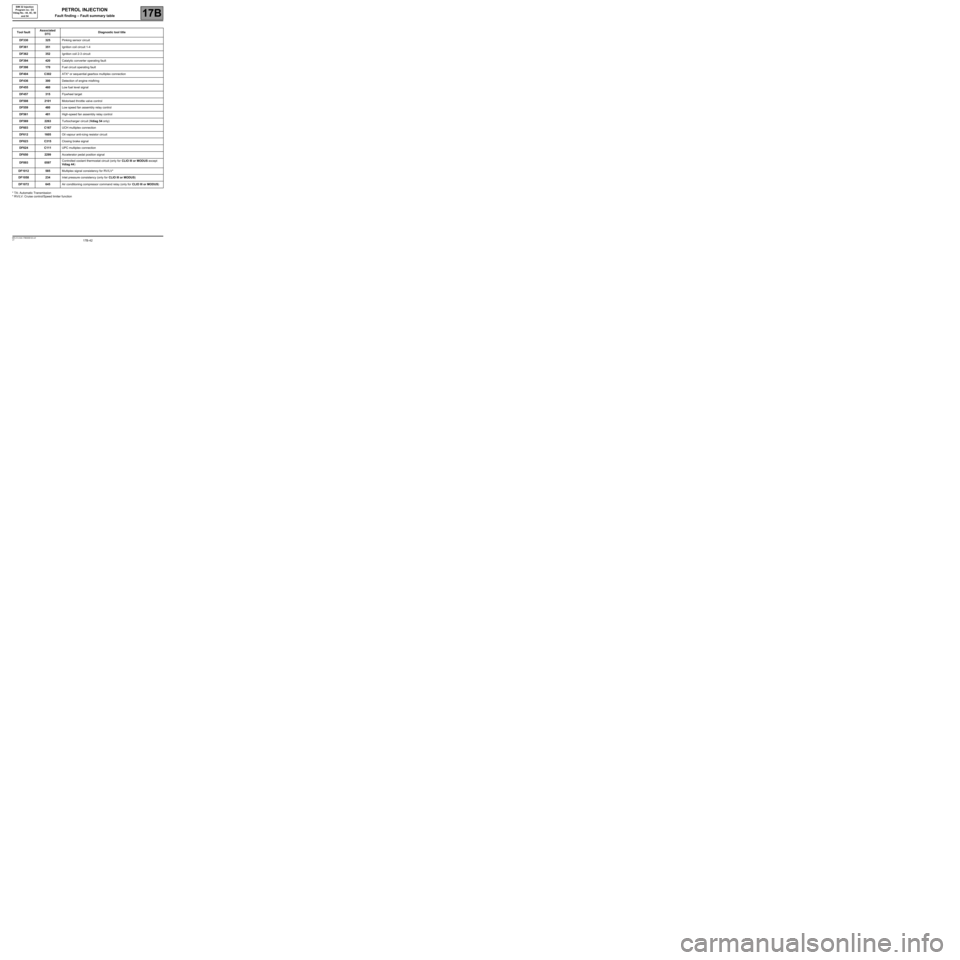
17B-42V7 MR-413-X44-17B000$120.mif
PETROL INJECTION
Fault finding – Fault summary table17B
SIM 32 Injection
Program no.: D3
Vdiag No.: 44, 4C, 50
and 54
* TA: Automatic Transmission
* RV/LV: Cruise control/Speed limiter function
Tool faultAssociated
DTCDiagnostic tool title
DF330325Pinking sensor circuit
DF361351Ignition coil circuit 1-4
DF362352Ignition coil 2-3 circuit
DF394420Catalytic converter operating fault
DF398170Fuel circuit operating fault
DF404C302ATX* or sequential gearbox multiplex connection
DF436300Detection of engine misfiring
DF455460Low fuel level signal
DF457315Flywheel target
DF5082101Motorised throttle valve control
DF559480Low speed fan assembly relay control
DF561481High-speed fan assembly relay control
DF5692263Turbocharger circuit (Vdiag 54 only)
DF603C167UCH multiplex connection
DF6121605Oil vapour anti-icing resistor circuit
DF623C315Closing brake signal
DF624C111UPC multiplex connection
DF6502299Accelerator pedal position signal
DF8930597Controlled coolant thermostat circuit (only for CLIO III or MODUS except
Vdiag 44)
DF1012585Multiplex signal consistency for RV/LV*
DF1058234Inlet pressure consistency (only for CLIO III or MODUS)
DF1072645Air conditioning compressor command relay (only for CLIO III or MODUS)
Page 43 of 348
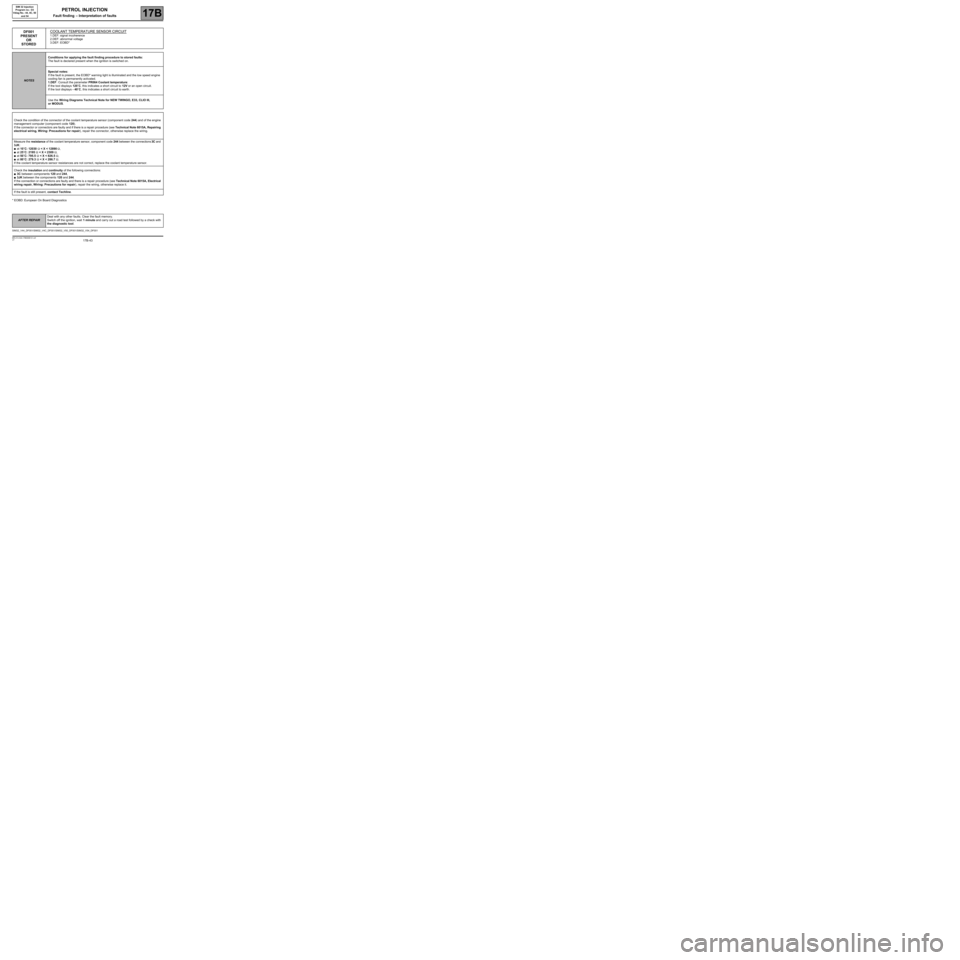
17B-43V7 MR-413-X44-17B000$131.mif
17B
SIM 32 Injection
Program no.: D3
Vdiag No.: 44, 4C, 50
and 54
* EOBD: European On Board Diagnostics
DF001
PRESENT
OR
STOREDCOOLANT TEMPERATURE SENSOR CIRCUIT
1.DEF: signal incoherence
2.DEF: abnormal voltage
3.DEF: EOBD*
NOTESConditions for applying the fault finding procedure to stored faults:
The fault is declared present when the ignition is switched on.
Special notes:
If the fault is present, the EOBD* warning light is illuminated and the low speed engine
cooling fan is permanently activated.
1.DEF: Consult the parameter PR064 Coolant temperature:
If the tool displays 120˚C, this indicates a short circuit to 12V or an open circuit.
If the tool displays - 40˚C, this indicates a short circuit to earth.
Use the Wiring Diagrams Technical Note for NEW TWINGO, E33, CLIO III,
or MODUS.
Check the condition of the connector of the coolant temperature sensor (component code 244) and of the engine
management computer (component code 120).
If the connector or connectors are faulty and if there is a repair procedure (see Technical Note 6015A, Repairing
electrical wiring, Wiring: Precautions for repair), repair the connector, otherwise replace the wiring.
Measure the resistance of the coolant temperature sensor, component code 244 between the connections 3C and
3JK:
●at 10˚C: 12030 Ω < X < 12890 Ω,
●at 25˚C: 2195 Ω < X < 2309 Ω,
●at 50˚C: 795.5 Ω < X < 826.5 Ω,
●at 80˚C: 279.3 Ω < X < 286.7 Ω.
If the coolant temperature sensor resistances are not correct, replace the coolant temperature sensor.
Check the insulation and continuity of the following connections:
●3C between components 120 and 244,
●3JK between the components 120 and 244.
If the connection or connections are faulty and there is a repair procedure (see Technical Note 6015A, Electrical
wiring repair, Wiring: Precautions for repair), repair the wiring, otherwise replace it.
If the fault is still present, contact Techline.
SIM32_V44_DF001/SIM32_V4C_DF001/SIM32_V50_DF001/SIM32_V54_DF001
PETROL INJECTION
Fault finding – Interpretation of faults
AFTER REPAIRDeal with any other faults. Clear the fault memory.
Switch off the ignition, wait 1 minute and carry out a road test followed by a check with
the diagnostic tool.
Page 44 of 348
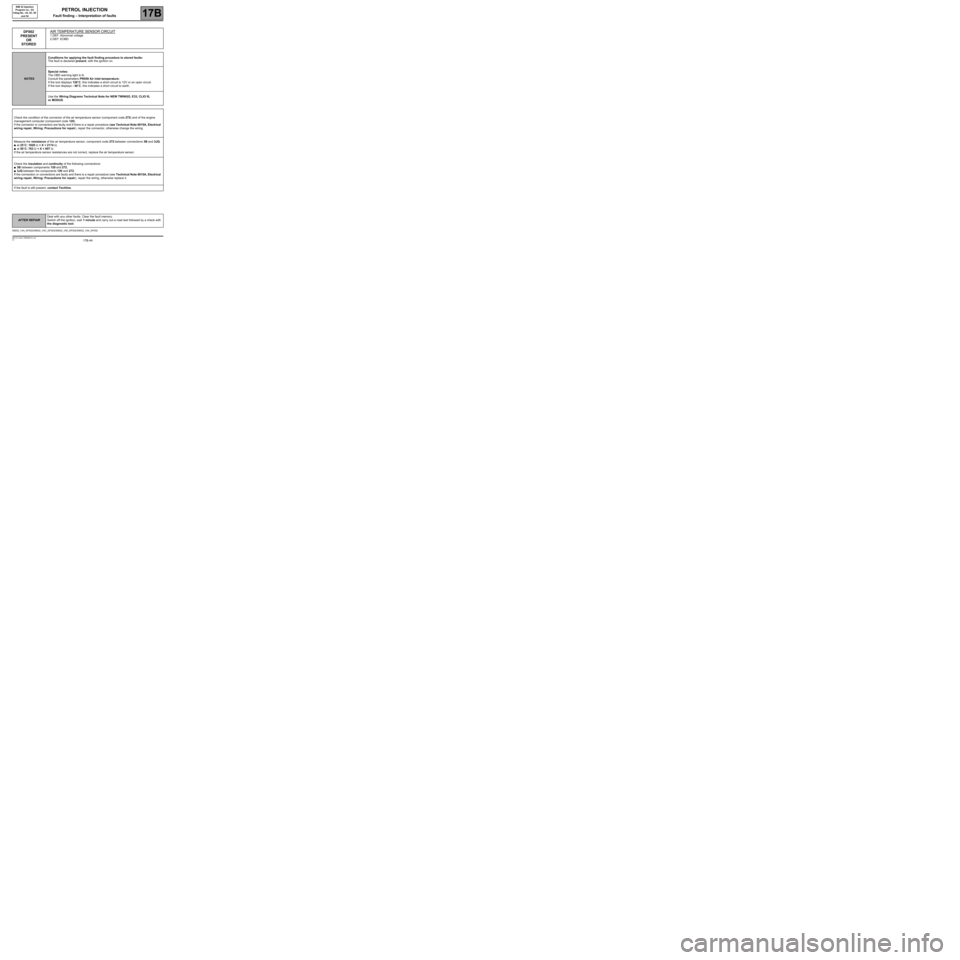
17B-44V7 MR-413-X44-17B000$131.mif
PETROL INJECTION
Fault finding – Interpretation of faults17B
SIM 32 Injection
Program no.: D3
Vdiag No.: 44, 4C, 50
and 54
DF002
PRESENT
OR
STOREDAIR TEMPERATURE SENSOR CIRCUIT
1.DEF: Abnormal voltage
2.DEF: EOBD
NOTESConditions for applying the fault finding procedure to stored faults:
The fault is declared present, with the ignition on.
Special notes:
The OBD warning light is lit.
Consult the parameters PR059 Air inlet temperature:
If the tool displays 120˚C, this indicates a short circuit to 12V or an open circuit.
If the tool displays - 40˚C, this indicates a short circuit to earth.
Use the Wiring Diagrams Technical Note for NEW TWINGO, E33, CLIO III,
or MODUS.
Check the condition of the connector of the air temperature sensor (component code 272) and of the engine
management computer (component code 120).
If the connector or connectors are faulty and if there is a repair procedure (see Technical Note 6015A, Electrical
wiring repair, Wiring: Precautions for repair), repair the connector, otherwise change the wiring.
Measure the resistance of the air temperature sensor, component code 272 between connections 3B and 3JQ:
●at 25˚C: 1928 Ω < X < 2174 Ω,
●at 50˚C: 763 Ω < X < 857 Ω.
If the air temperature sensor resistances are not correct, replace the air temperature sensor.
Check the insulation and continuity of the following connections:
●3B between components 120 and 272,
●3JQ between the components 120 and 272.
If the connection or connections are faulty and there is a repair procedure (see Technical Note 6015A, Electrical
wiring repair, Wiring: Precautions for repair), repair the wiring, otherwise replace it.
If the fault is still present, contact Techline.
SIM32_V44_DF002/SIM32_V4C_DF002/SIM32_V50_DF002/SIM32_V54_DF002
AFTER REPAIRDeal with any other faults. Clear the fault memory.
Switch off the ignition, wait 1 minute and carry out a road test followed by a check with
the diagnostic tool.
Page 45 of 348
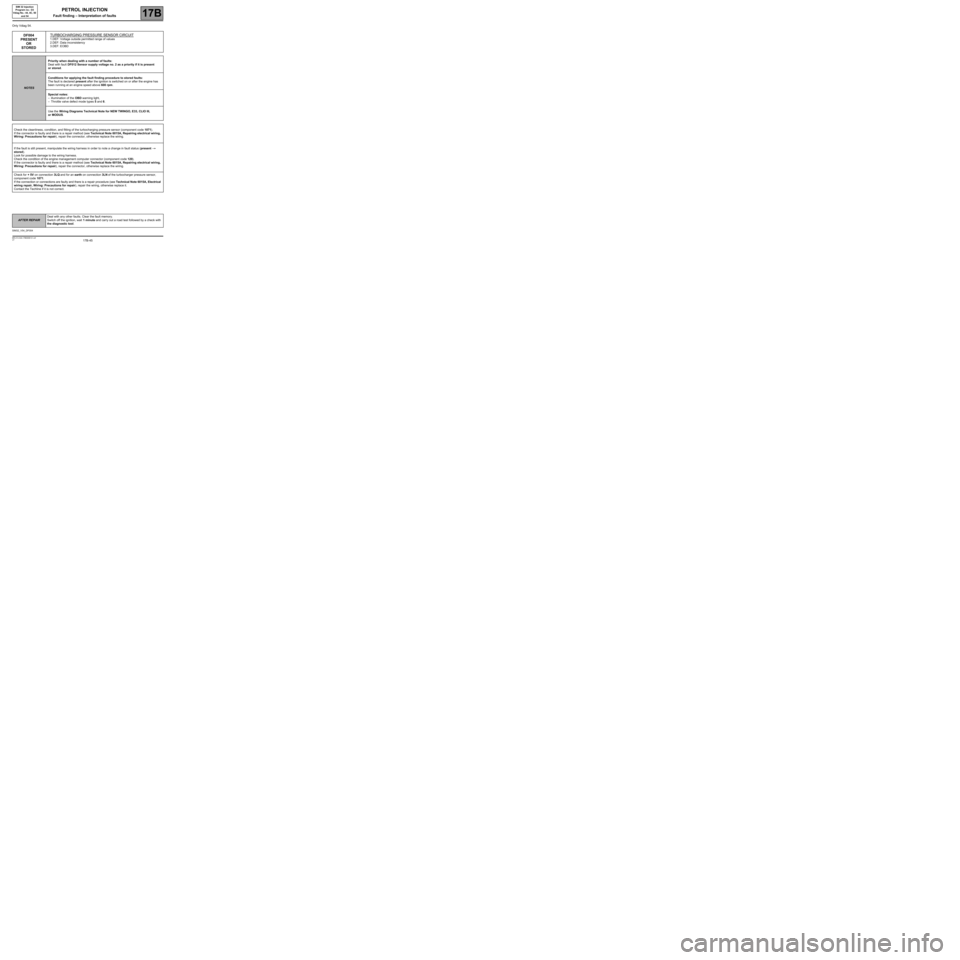
17B-45V7 MR-413-X44-17B000$131.mif
PETROL INJECTION
Fault finding – Interpretation of faults17B
SIM 32 Injection
Program no.: D3
Vdiag No.: 44, 4C, 50
and 54
Only Vdiag 54.
DF004
PRESENT
OR
STOREDTURBOCHARGING PRESSURE SENSOR CIRCUIT
1.DEF: Voltage outside permitted range of values
2.DEF: Data inconsistency
3.DEF: EOBD
NOTESPriority when dealing with a number of faults:
Deal with fault DF012 Sensor supply voltage no. 2 as a priority if it is present
or stored.
Conditions for applying the fault finding procedure to stored faults:
The fault is declared present after the ignition is switched on or after the engine has
been running at an engine speed above 600 rpm.
Special notes:
–illumination of the OBD warning light,
–Throttle valve defect mode types 5 and 6.
Use the Wiring Diagrams Technical Note for NEW TWINGO, E33, CLIO III,
or MODUS.
Check the cleanliness, condition, and fitting of the turbocharging pressure sensor (component code 1071).
If the connector is faulty and there is a repair method (see Technical Note 6015A, Repairing electrical wiring,
Wiring: Precautions for repair), repair the connector, otherwise replace the wiring.
If the fault is still present, manipulate the wiring harness in order to note a change in fault status (present
→
stored).
Look for possible damage to the wiring harness.
Check the condition of the engine management computer connector (component code 120).
If the connector is faulty and there is a repair method (see Technical Note 6015A, Repairing electrical wiring,
Wiring: Precautions for repair), repair the connector, otherwise replace the wiring.
Check for + 5V on connection 3LQ and for an earth on connection 3LN of the turbocharger pressure sensor,
component code 1071.
If the connection or connections are faulty and there is a repair procedure (see Technical Note 6015A, Electrical
wiring repair, Wiring: Precautions for repair), repair the wiring, otherwise replace it.
Contact the Techline if it is not correct.
SIM32_V54_DF004
AFTER REPAIRDeal with any other faults. Clear the fault memory.
Switch off the ignition, wait 1 minute and carry out a road test followed by a check with
the diagnostic tool.
Page 47 of 348

17B-47V7 MR-413-X44-17B000$131.mif
PETROL INJECTION
Fault finding – Interpretation of faults17B
SIM 32 Injection
Program no.: D3
Vdiag No.: 44, 4C, 50
and 54
DF011
PRESENT
OR
STOREDSENSOR SUPPLY VOLTAGE NO. 1
1.DEF: Abnormal voltage
2.DEF: Fault on potentiometer supply 1
3.DEF: EOBD
NOTESPriorities when dealing with a number of faults:
Deal with the fault DF084 Actuator relay control circuit or DF046 Battery voltage as
a priority if they are present or stored.
Conditions for applying the fault finding procedure to stored faults:
The fault is declared present when the ignition is switched on.
Special notes:
In the event of a short circuit to earth or to + 12V, the severity level 1 warning light is
illuminated.
The injection changes over to defect modes 4 and 5, which causes:
–the speed to be limited to 66 mph (110 km/h),
–a loss of power when accelerating (impression that the accelerator pedal is spongy),
–loss of signals from other computers and switch to safe mode on automatic and
sequential gearboxes, if required.
The OBD warning light may illuminate, depending on the sensors affected.
Use the Wiring Diagrams Technical Note for NEW TWINGO, E33, CLIO III,
or MODUS.
Check the cleanliness and condition of the sensor connections for supply voltage assembly No.1:
–manifold pressure sensor, component code 147,
–pedal potentiometer (gang 2), component code 921,
–rotary switch, component code 689,
–refrigerant fluid pressure sensor, component code 1202.
Check the condition of the engine management computer connector, component code 120.
If the connector or connectors are faulty and if there is a repair procedure (see Technical Note 6015A, Repairing
electrical wiring, Wiring: Precautions for repair), repair the connector, otherwise replace the wiring.
SIM32_V44_DF011/SIM32_V4C_DF011/SIM32_V50_DF011/SIM32_V54_DF011
AFTER REPAIRDeal with any other faults. Clear the fault memory.
Switch off the ignition, wait 1 minute and carry out a road test followed by a check with
the diagnostic tool.
Page 49 of 348
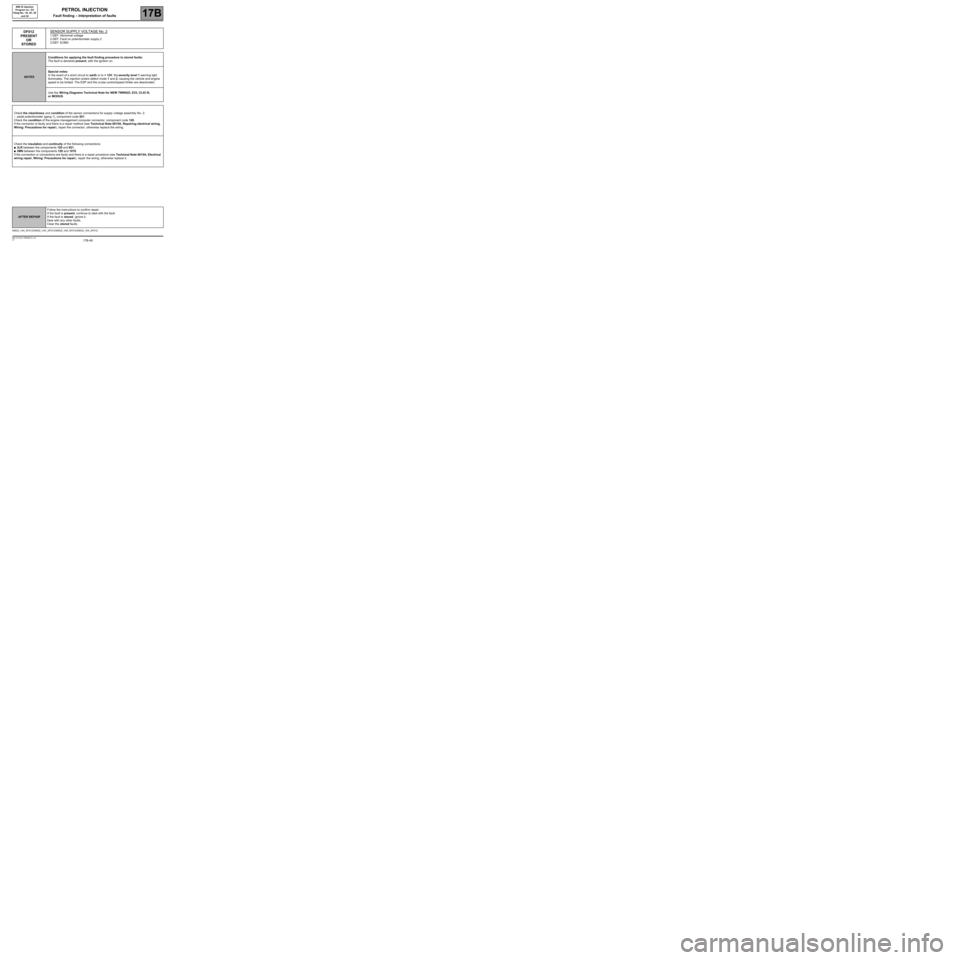
17B-49V7 MR-413-X44-17B000$131.mif
PETROL INJECTION
Fault finding – Interpretation of faults17B
SIM 32 Injection
Program no.: D3
Vdiag No.: 44, 4C, 50
and 54
DF012
PRESENT
OR
STOREDSENSOR SUPPLY VOLTAGE No. 2
1.DEF: Abnormal voltage
2.DEF: Fault on potentiometer supply 2
3.DEF: EOBD
NOTESConditions for applying the fault finding procedure to stored faults:
The fault is declared present, with the ignition on.
Special notes:
In the event of a short circuit to earth or to + 12V, the severity level 1 warning light
illuminates. The injection enters defect mode 1 and 2, causing the vehicle and engine
speed to be limited. The ESP and the cruise control/speed limiter are deactivated.
Use the Wiring Diagrams Technical Note for NEW TWINGO, E33, CLIO III,
or MODUS.
Check the cleanliness and condition of the sensor connections for supply voltage assembly No. 2:
–pedal potentiometer (gang 1), component code 921.
Check the condition of the engine management computer connector, component code 120.
If the connector is faulty and there is a repair method (see Technical Note 6015A, Repairing electrical wiring,
Wiring: Precautions for repair), repair the connector, otherwise replace the wiring.
Check the insulation and continuity of the following connections:
●3LR between the components 120 and 921,
●3MN between the components 120 and 1076.
If the connection or connections are faulty and there is a repair procedure (see Technical Note 6015A, Electrical
wiring repair, Wiring: Precautions for repair), repair the wiring, otherwise replace it.
SIM32_V44_DF012/SIM32_V4C_DF012/SIM32_V50_DF012/SIM32_V54_DF012
AFTER REPAIRFollow the instructions to confirm repair:
If the fault is present, continue to deal with the fault.
If the fault is stored, ignore it.
Deal with any other faults.
Clear the stored faults.
Page 64 of 348
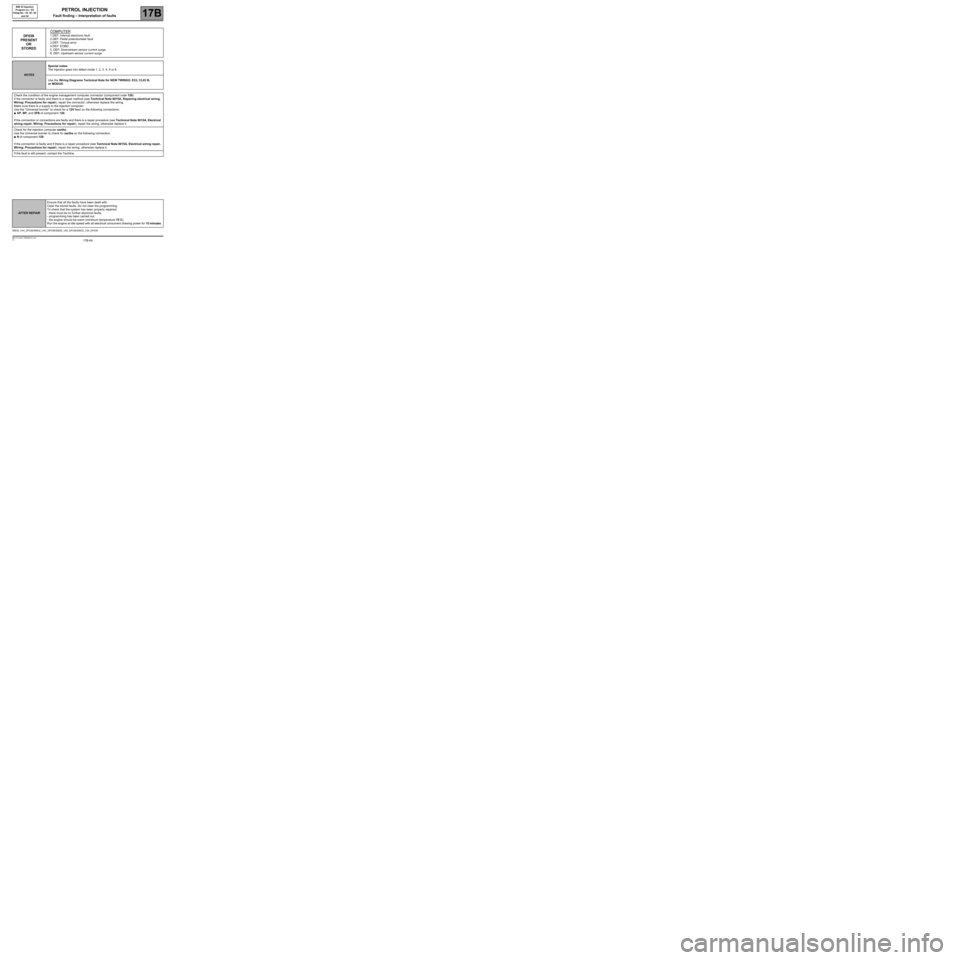
17B-64V7 MR-413-X44-17B000$131.mif
PETROL INJECTION
Fault finding – Interpretation of faults17B
SIM 32 Injection
Program no.: D3
Vdiag No.: 44, 4C, 50
and 54
DF038
PRESENT
OR
STOREDCOMPUTER1.DEF: Internal electronic fault
2.DEF: Pedal potentiometer fault
3.DEF: Torque error
4.DEF: EOBD
5. DEF: Downstream sensor current surge
6. DEF: Upstream sensor current surge
NOTESSpecial notes:
The injection goes into defect mode 1, 2, 3, 4, 5 or 6.
Use the Wiring Diagrams Technical Note for NEW TWINGO, E33, CLIO III,
or MODUS.
Check the condition of the engine management computer connector (component code 120).
If the connector is faulty and there is a repair method (see Technical Note 6015A, Repairing electrical wiring,
Wiring: Precautions for repair), repair the connector, otherwise replace the wiring.
Make sure there is a supply to the injection computer:
Use the "Universal bornier" to check for a 12V feed on the following connections:
●AP, BP, and 3FB of component 120.
If the connection or connections are faulty and there is a repair procedure (see Technical Note 6015A, Electrical
wiring repair, Wiring: Precautions for repair), repair the wiring, otherwise replace it.
Check for the injection computer earths:
Use the Universal bornier to check for earths on the following connection:
●N of component 120.
If the connection is faulty and if there is a repair procedure (see Technical Note 6015A, Electrical wiring repair,
Wiring: Precautions for repair), repair the wiring, otherwise replace it.
If the fault is still present, contact the Techline.
SIM32_V44_DF038/SIM32_V4C_DF038/SIM32_V50_DF038/SIM32_V54_DF038
AFTER REPAIREnsure that all the faults have been dealt with.
Clear the stored faults. Do not clear the programming.
To check that the system has been properly repaired:
- there must be no further electrical faults,
- programming has been carried out,
- the engine should be warm (minimum temperature 75˚C).
Run the engine at idle speed with all electrical consumers drawing power for 15 minutes.